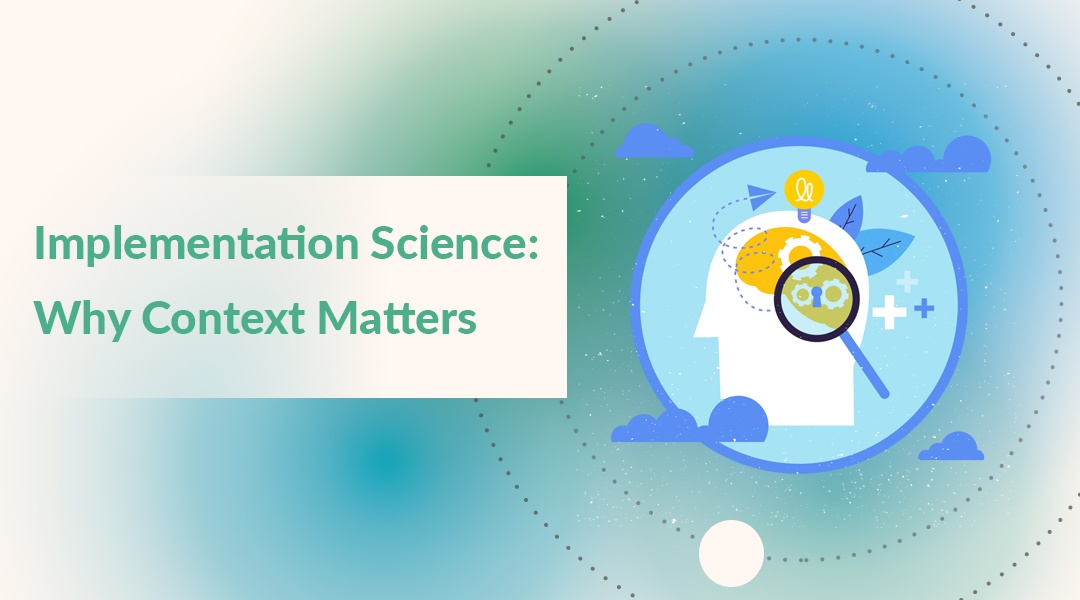 ercloudhealth.com/uk/news/implementation-science-measuring-the-outcomes-of-an-implementation
ercloudhealth.com/uk/news/implementation-science-measuring-the-outcomes-of-an-implementation
This series of blogs will explore the relevance of implementation science to internet-delivered interventions, and will provide a high level overview of the field. The first blog in the series provided a short introduction to the topic, the second explored some relevant implementation outcomes and this final blog will elaborate on the role of context in implementations of internet-delivered treatments.
When we choose to implement internet-delivered interventions (IDIs) within our services, the most common goal is for our patients to receive better care, or for certain service outputs to increase. Under ideal circumstances, the introduction of an IDI should be accompanied by an implementation effort, with key goals and deliverables identified. However, the context where the implementation effort takes place is also of key importance for consideration.
Pfadenhauer et al. (2015) define context as the following:
-
A set of characteristics and circumstances that consist of active and unique factors that surround the implementation.
-
Interacts, influences, modifies and facilitates or constrains the intervention and its implementation. It is usually considered in relation to an intervention or object, with which it actively interacts.
-
It is a versatile construct, embracing not only the physical setting but also roles, interactions and relationships.
The above definition expands upon context to illustrate it as much more than the physical environment. Contexts are dynamic, such that the behaviours that define them are constantly negotiated and renegotiated by those who frequent them and work in them. Context is relevant to implementation science, where we must acknowledge that our implementation plans should not be developed in a vacuum – tailoring an implementation plan to the context in which the plan is being actualised is key to its success.
When considering the behaviours and habits associated with certain contexts, Nilsen et al. (2012) state that contextual cues promote certain behaviours. Where these behaviours may initially be internally driven (e.g. behaviour stemming from attitudes and beliefs), they soon become the normative response naturally occurring cues within the context. For instance, in a model of stepped care, a service may allocate individuals presenting with depression to a psychoeducation group as a prequel to face-to-face therapy. This practice may have been initially piloted in the service due to the evidence supporting it, and due to its efficiency it became a normative behaviour. Therefore, the thinking behind this activity shifts from “This is a great idea to improve our service”, to “This is how we operate in this context in response to these clinical presentations”. As an established facet of the service context, this practice can have numerous behaviours and bureaucratic processes supporting it, such as case managers querying any changes from service-as-normal, or requiring extra paperwork when deviations occur are made to typical treatment plans.
Certain contextual factors, however, can create issues when trying to foster innovation within the healthcare field; for example, a barrier highlighted by Vis et al. (2018) to the implementation of IDIs were clinician and patient attitudes towards the appropriateness of IDIs for mental health problems – If what the service is doing is working, why are we changing things? These attitudes can be reinforced by other contextual factors, such as having more clarity for the delivery of face-to-face interventions versus online interventions, or a lack of electronic health record integration with the IDI. Vis et al. (2018) further illustrate that certain contextual facilitators can also promote the implementation of IDIs, such as leadership capacity to change work processes and influence culture. From this brief insight, we can see that context has quite the role to play when implementing IDIs, and that enacting and driving forward change in healthcare contexts is key; ultimately benefiting our patients and services
On a separate but related front, contextual factors are rarely reported when it comes to randomised control trials and research in service settings. Often it is the case that we gather data and report on the relevant clinical outcomes associated with our IDIs, yet fail to account for the contextual factors that may have facilitated success or created barriers to the implementation of a research trial. In fact, there are scientific methods that have been developed to analyse and account for the role of context. For example, the Context and Implementation of Complex Intervention framework (Pfadenhauer et al., 2017) provides a comprehensive lens to analyse context; the framework splits context across seven domains and elaborates further on aspects of implementation and setting. However, it can be the case that funding may be limited in regards to integrating such methodologies into studies that are principally focussed on measuring clinical outcomes.
In summary, when developing a strategy for the implementation of an IDI, it is important to consider the context in which the intervention is being implemented. Contextual factors can both facilitate and hinder implementation efforts and it is important that these are illustrated in research. Doing so will allow for the dissemination and spread of ideas that can be beneficial to healthcare providers when the decision is made to implement novel interventions.
Throughout this series of blogs, we have provided a brief illustration of implementation science and its relevance to IDIs. As a final note in this series, we would like to emphasise that a comprehensive implementation effort is necessary to ensure the success of any novel intervention, IDI or otherwise, in any context. At SilverCloud, we are committed to furthering the field of implementation science to better support our customers in their provision of IDIs and ultimately to benefit the clients who avail of our services.
References
Pfadenhauer, L. M., Mozygemba, K., Gerhardus, A., Hofmann, B., Booth, A., Lysdahl, K. B., ... & Rehfuess, E. A. (2015). Context and implementation: a concept analysis towards conceptual maturity. Zeitschrift für Evidenz, Fortbildung und Qualität im Gesundheitswesen, 109(2), 103-114.
Pfadenhauer, L. M., Gerhardus, A., Mozygemba, K., Lysdahl, K. B., Booth, A., Hofmann, B., ... & Rehfuess, E. (2017). Making sense of complexity in context and implementation: the Context and Implementation of Complex Interventions (CICI) framework. Implementation science, 12(1), 21.
Nilsen, P., Roback, K., Broström, A., & Ellström, P. E. (2012). Creatures of habit: accounting for the role of habit in implementation research on clinical behaviour change. Implementation Science, 7(1), 53.
Vis, C., Mol, M., Kleiboer, A., Bührmann, L., Finch, T., Smit, J., & Riper, H. (2018). Improving Implementation of eMental Health for Mood Disorders in Routine Practice: Systematic Review of Barriers and Facilitating Factors. JMIR mental health, 5(1).








